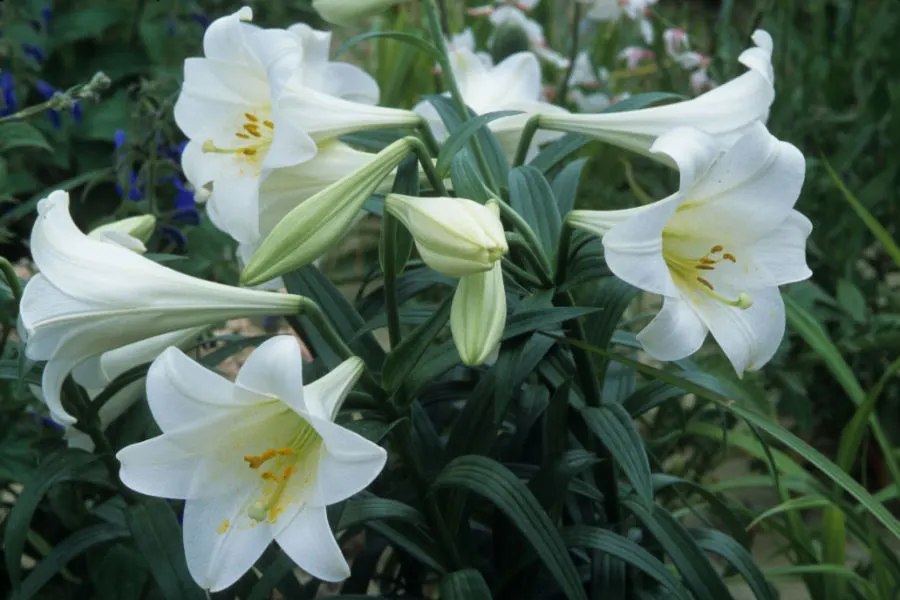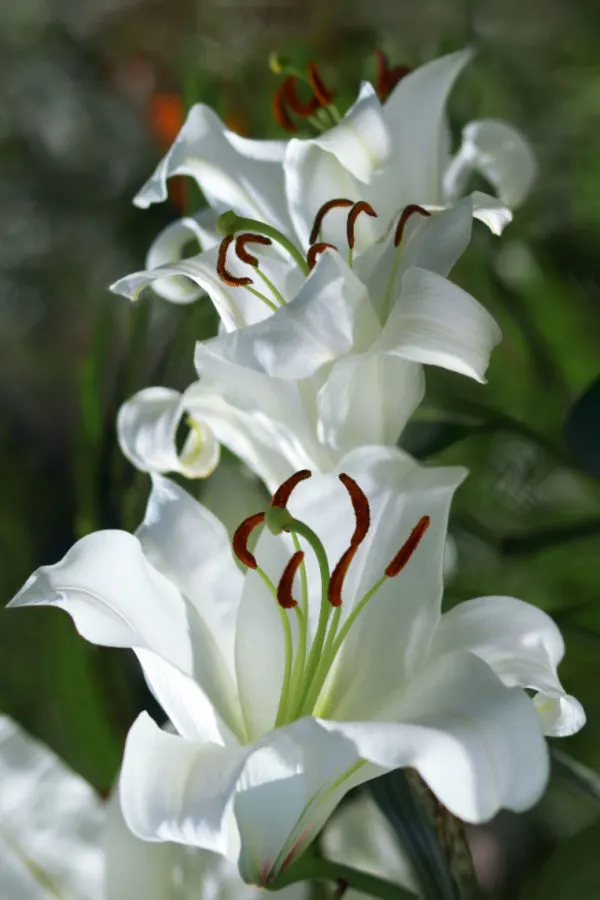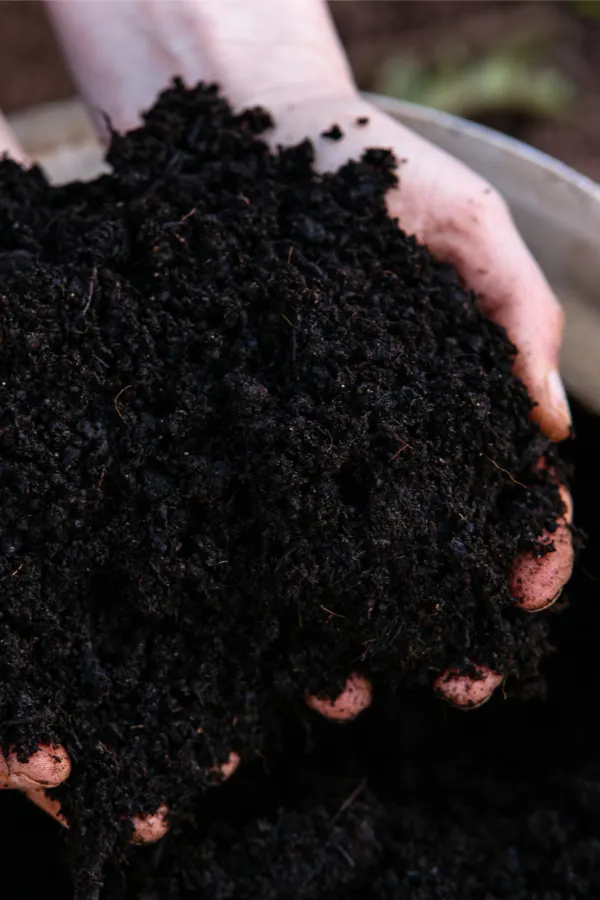Looking for what to do and how to care for that beautiful Easter lily you have growing inside after it blooms?
The Easter lily plant has certainly become the go-to gift during the Easter season. Who doesn’t love the amazing color and beauty of this blooming lily. Its soft, trumpet shaped flowers and ultra-bright white blooms are a sure sign the Easter season is upon us. Of course, it also often signals that spring has arrived – or is at least close at hand!
The Easter Lily giving tradition stems all the way back to the early 1900’s and the World War I era. It is thought that an Oregon soldier brought back a collection of the beautiful hybrid bulbs and gave them as gifts to friends and family.

From that time on, the tradition of the Easter lily only grew. Especially after local growers in Oregon and the coastal California area found out how well they could grow them there. Still today, nearly all of the Easter lily bulbs that are sold hail from the Oregon and California coastal areas.
The lily has certainly surged in popularity – enough to now rank among the top 5 of all potted plants. But even though its notoriety has soared, many still struggle with how to care for this plant. Especially after it has finished blooming and the Easter season has long passed!
Can Easter Lilies Grow Outdoors?
So what is the best way to care for these beautiful plants after they complete their blooming cycle? Do they need to remain indoors as a houseplant? Can they be planted outdoors? Will they bloom again at the same time year after year?
As it turns out, in nearly all climates, you can not only grow Easter lilies indoors as a houseplant – but also enjoy them flowering outdoors in flowerbeds or containers. The good news is that however and wherever you choose to grow them, caring for an Easter lily is a breeze!
With that in mind, here is a look at what do with your Easter lily after it blooms, including how to care for it as a houseplant, or an outdoor perennial.

How To Care For An Easter Lily Plant After It Blooms
Easter Lilies As A Houseplant
One of the easiest methods for enjoying your Easter lily for many years to come is as a houseplant. If this is how you will be keeping your plant, the first thing you will want to do is remove the shiny or decorative wrap that so often accompanies the plants when given as gifts.
Decorative wraps are more than fine to keep on for the Easter season, but allowing them to remain after the plant blooms can cause long-term issues. Both with drainage for the plant, and air-flow as well.
As your lily bloom starts to fade, cut it off right below the stem. Do not cut back the green stem or any of the foliage at this point. Allow these to die back on their own, as it helps to send power to the bulb below for the next blooming cycle.
For good indoor growth, locate your lily in an area that receives a lot of light, but not direct sunlight. They prefer rooms that are on the cooler side, so avoid placing them in locations that get more hot or humid. For best results, temperatures between 65° and 75°(F) are ideal.
Although Easter lilies can grow as houseplants indoors all year round, they will thrive on porches and patios with shade during the summer months. Always keep your lilies far away from heating vents, space heaters, fireplaces and other direct heat sources, they simply cannot handle direct heat.

Watering Indoors – How To Care For An Easter Lily Plant After It Blooms
When growing as a houseplant, proper watering is essential to keep lilies happy and healthy. Overwatering is more of an issue than underwatering as the bulbs of Easter lilies are prone to rot out in heavy moisture.
Always allow the top layer of soil to completely dry out before watering. Always water with untreated tap water, rain water or purified water. Municipal or treated water (i.e water softener) can contain salts and chemicals that can injure houseplants.
Fertilizing Indoors
Easter lilies are not big feeders from the soil, but a bit of power every few months will help keep bulbs strong and help to power new blooms.
It is not necessary to fertilize the plant during its blooming cycle. However, once the plant completes flowering, apply a traditional all-purpose potted plant fertilizer every few months through summer and winter. This will help your lily store up power for blooming the following season. Affiliate Product Link: Espoma Indoor Organic Fertilizer Plant Food
Growing Easter Lilies Outdoors – How To Care For An Easter Lily Plant After It Blooms
Although there are a few specialized varieties of Easter lilies not suited for outdoor growing, most varieties found in nurseries and stores are winter hardy from growing zones 5 through 8. See: How To Understand Growing Zones & Hardiness Maps

If you happen to be fortunate enough to live in one of the those growing zones, you can plant your Easter lily as a permanent outdoor perennial plant. As an outdoor plant, an Easter lily can be a great accent to other bulbous plants and perennials.
If you will be planting your potted lily outside, one thing you must do first is allow it to completely finish blooming indoors before transplanting. Planting when the lily is still in bloom can cause excessive strain and stress on the plant.
Once your lily has finished blooming, and the threat of a frost has passed, remove all of the spent flowers. Again, leave the stems and foliage intact to help energize the bulbs. As for location, lilies prefer a mostly sunny location with fertile, well-draining soil.
How To Transplant Easter Lilies Outdoors
Start by selecting a space in your landscape that receives at least 6 to 8 hours of sunlight daily. Before planting, amend the soil around your planting hole with a few cups of compost. This will help to provide nutrients to the bulb as it adjusts to life outdoors.
The compost will also help loosen the soil around the bulb. That in turn will help it set new roots, and keep the bulb from becoming overly wet. Next, place the top of the bulb six-inches below the surface of the soil. Lightly pack the soil around the plant – making sure the plant’s surface is equal to the surrounding soil.

Water well for the first few weeks to help the plant establish its bulbous roots in the soil. Be careful not to overwater, as it can rot the bulb below. The soil should be moist but not saturated.
Allow the plant to die off completely in the fall before cutting back to the ground. Mulch with a few inches of leaves, straw or shredded hardwood to keep protected through the cold winter months. In the spring, as new growth appears, slightly move back the mulch to let the soil warm faster.
Expect A Later Bloom…
Remember that Easter lilies in stores are forced to bloom early. So for most, an Easter lily plant placed in the landscape will bloom a bit later in late spring. Here is to enjoying your Easter lily for years to come!
Follow Our Facebook Page For Great Gardening Tips And Advice! This Is My Garden Facebook Page
This Is My Garden is a garden website created by gardeners, for gardeners. Jim and Mary Competti have been writing gardening, DIY and recipe articles and books and speaking for over 15 years from their 46 acre Ohio farm. They publish three articles every week, 52 weeks a year. Sign up today to follow via email, or follow along!

